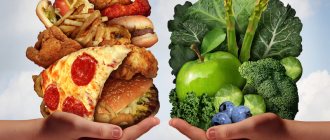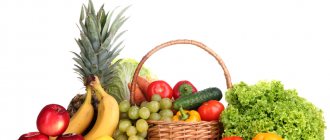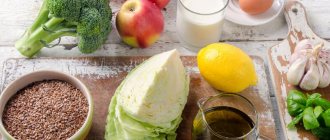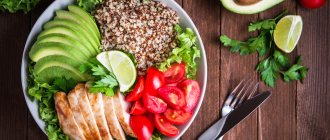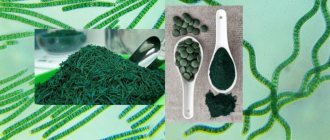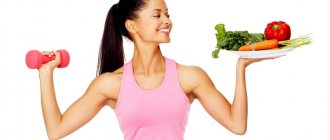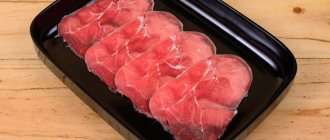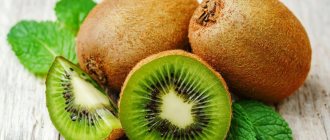In this article we will tell you:
- Basic principles of a fat diet and its effect on the body
- Healthy and unhealthy fats
- How much fat to eat
- Benefits of a fat diet
- Disadvantages and contraindications
- Results of a fat diet
- Menu planning for the week
- Fat diet menu for 3 days
- What to do if a breakdown occurs
- The right way out of a fat diet
Just a few years ago people were afraid of fats, and low-fat foods were popular among the population. Now marketing campaigns are attracting other health benefits - “healthy fats”, “rich in Omega 3”.
A diet rich in fat is one of the most affordable ways to lose weight quickly and safely. It sounds appealing - you can eat delicious meals with healthy fats and burn excess fat at the same time. To understand whether it is right for you, to learn about the advantages and disadvantages, what principles to follow on a fat diet in order to get results and not harm your health, read the article.
Basic principles of a fat diet and its effect on the body
A high-fat diet involves reducing carbohydrate intake and increasing protein and fat intake.
With a fat diet, the composition of an average meal is as follows: 75% fat, 20% protein and 5% carbohydrates. When the body consumes less than 20 grams of carbohydrates per day, it enters ketosis.
Ketosis
is a metabolic condition in which your body uses fat and ketones rather than glucose (sugar) as its primary fuel source. Ketones, or ketone bodies, are synthesized by the liver from fat that comes from food and from body fat.
Since the diet involves reducing carbohydrates in the diet, you should gradually reduce their amount, starting with fast carbohydrates - all industrial sweets, baked goods, fruits with a glycemic index. And then limit starchy vegetables, grains and legumes.
The basis of the carbohydrate component on a fatty diet is vegetables and greens.
For most people, this transition can take anywhere from a few days to a week.
Effects of ketosis on the body
Positive:
- Weight loss.
- Reducing the amount of fat in the body.
- Reduced cravings for sweets and food in general.
- Increased energy.
- Clarity of thinking.
Negative:
- Specific breathing.
- Keto flu.
- Constipation/diarrhea.
- Sensation of muscle contraction.
- Sleep disturbance.
Types of fatty diets:
- Keto diet/ketogenic diet.
- LCHF LCHF (low carb high fat - “low carbohydrates, high fat”).
- Paleo diet.
- Atkins diet.
- AIP.
Despite some differences in the listed diets, the basic components of the diet are similar.
Main list of products:
- all types of natural meat;
- healthy natural oils;
- eggs;
- fish;
- mushrooms;
- whole dairy products;
- vegetables.
Additional products:
- nuts;
- berries;
- cocoa/coffee;
- natural sweeteners.
We recommend
“Fiber-rich foods: benefits for the body” Read more
List of foods limited in the diet:
- unsweetened fruits;
- moderately starchy vegetables (carrots, beets);
- unsweetened alcohol;
- industrially processed products (sausages, semi-finished products).
Strict exception:
- cereal products;
- glucose- and fructose-containing products, including hidden sugar;
- sweet fruits (bananas), dried fruits;
- high-starch foods;
- cereals
What are the differences between fat diets? The ratio of macronutrients in the diet:
- BJU for the keto diet:
20% / 75% / 5%.
- BJU for
LCHF diet:
20% / 65% / 15%.
Since the diet is called a fat diet, first of all it is worth understanding which foods rich in fats to focus on.
Permitted and prohibited products
A high-fat diet causes a lot of controversy, especially among nutritionists. But numerous studies have proven its effectiveness in the fight against excess weight. Limiting carbohydrate foods and replacing them with fats helps you lose weight gradually, eliminating sudden weight changes. The absence of glucose helps to launch fat burning processes, reducing volumes.
But still, it will not be possible to completely avoid carbohydrates, agrees the author of the method. Allowable quantity - 50 g. in a day. This volume is sufficient to prevent ketosis, a process in which the body’s own proteins are destroyed. The condition is accompanied by a deterioration in well-being, a decrease in energy resources and cognitive abilities.
The most valuable, according to Kwasniewski's diet, are eggs and dairy products, followed by meat dishes. A fat diet for weight loss requires strict adherence to all recommendations, including diet.
Authorized products:
- meat - pork, lamb, goose, duck, chicken, turkey;
- offal - liver, lungs, heart, kidneys;
- salo;
- fatty sea fish;
- eggs - from 5 to 8 pcs. per day;
- dairy products with a high percentage of fat;
- durum wheat pasta;
- bread toast;
- vegetables, but not more than 50 grams;
- vegetable oils;
- nuts.
For many, the fat diet system is a real example of a celebration of the belly. Dr. Kwasniewski’s innovations did not affect drinks. Alcohol, sweet soda, juices, and fruit drinks are traditionally prohibited. The drinking regime involves an unlimited amount of water; you can also drink herbal teas, coffee, and chicory.
Prohibited products:
- legumes;
- seafood;
- porridge;
- bakery products, sweet pastries;
- fruits;
- confectionery;
- alcohol.
Despite the name, the fat diet involves carbohydrates in the diet, but in limited quantities. Preference is given to potatoes, pasta, you can also use all types of vegetables, but no more than one per day.
Healthy and unhealthy fats
Fats
- These are organic compounds that consist of esters of glycerol and fatty acids.
We can get several types of fats from food: trans fats, saturated fats and unsaturated fats. What role does each type have? Let's understand without labels “good/bad”, because you should always take into account the quantity and individual recommendations for BJU - they will never be the same.
- Saturated fats
– strengthen the cellular structure and nourish the brain, are indispensable for building up the protective layer of internal organs, are their shock absorber and retainer.
They are considered evil and are advised to be completely excluded from the diet in order to avoid high cholesterol. But there is another opinion - they put it in the ranks of superfoods that give energy and feed our brain.
In the average person's diet, sources of saturated fat include foods such as cheese, processed foods with cheese, baked goods that contain fat, desserts such as ice cream, industrial meat products, eggs and butter. These are mainly products of animal origin.
We need small amounts of saturated fat for healthy hormonal levels. For example, in the form of coconut oil. It's not just saturated fat, it's mostly made up of medium chain triglycerides, which are much easier to digest than many other fats due to less stress on the gallbladder.
On average, a normal intake of saturated fat is considered to be around 5-7%.
- Unsaturated fats
are fatty acids with one or more double bonds.
They are divided into:
- monounsaturated fatty acids (MUFA) - contain one double bond;
- polyunsaturated fatty acids (PUFAs) - contain two or more double bonds.
Research has shown that these types of fats help reduce inflammation in the body. They also lower cholesterol levels and reduce the risk of cardiovascular disease.
Avocados, chia seeds, peanut butter and olive oil are all plant-based sources of unsaturated fats.
In addition, control your intake of Omega 3 fatty acids.
An adult needs to consume at least one gram of omega-3 per day.
Fatty fish
- the best source of omega-3 fatty acids. But not all varieties of fish contain sufficient amounts of these beneficial substances.
Omega 3 in fish oil performs many beneficial functions in the human body: helps the synthesis of sex hormones; stimulates brain function, memory, attention; improves joint mobility; responsible for lipid balance and other metabolic processes; fights cancer processes.
If you follow a plant-based diet or are allergic to fish oil, it is possible to get Omega 3 from seeds and nuts. Chia seeds are a great option.
They are very low in calories and rich in nutrients. Chia seeds contain almost no carbohydrates, making them an ideal ingredient for the keto diet. They can enhance the flavor of your dishes without adding calories or carbs.
They are quite a versatile ingredient and can be added to snacks in a variety of ways. Here are some quick ideas:
Superfood smoothie
:
Soak chia in water overnight. The seeds will turn into a gel-like substance that can be mixed into a fancy smoothie along with lime juice and salt. If you like your smoothies sweet, add strawberries or other berries with coconut milk.
What are trans fats?
These are saturated fats that have been oxidized or heated to 180 degrees or higher. The most famous trans fat is margarine. Heating vegetable oils is a direct path to the appearance of trans fats.
These fats are found in foods that contain partially hydrogenated oils, such as fried potatoes and other fried foods, some commercial baked goods, and packaged foods such as cookies, crackers, and muffins.
These types of fats cause inflammation and increase cholesterol levels, leading to an increased risk of heart disease. Trans fats reduce the body's sensitivity to insulin and increase the risk of diabetes.
We recommend
“Foods rich in potassium: why is it simply impossible to live without them?” More details
If everything is clear with trans fats, in many countries their use is even officially prohibited due to the negative effect on health.
And in other types of fats there should be a balance. If you use coconut oil one day and ghee or avocado the next, you will be getting a variety of fats that will best support your health.
Doctors' opinions
Natalya Sergeevna, phlebologist, Astrakhan
I do not support this technique, since animal fats lead to blockage of veins, the formation of cholesterol plaques and blood clots. It is better to stick to the golden mean - eat high-calorie foods, but in reasonable quantities. The body also needs carbohydrates.
Vyacheslav Nikitin, nutritionist, Krasnodar
I prescribed this diet several times, the results were positive in 80 cases. If there are no contraindications, then you can safely experiment.
Elena Anatolyevna Svishchenko, nutritionist, Moscow
Consumption of 8 eggs per day is too much, but the nutrition is no different from the usual diet. The first time I recommended such weight loss to my cousin, as she was unrestrained when it came to meat and lard. The dynamics of weight loss were positive.
How much fat to eat
There is no single figure for everyone; it is important to correctly individually calculate your amount of fat during the day. To do this, you need to remember how daily calories are distributed:
- 75% fat
- 20% proteins
- 5% carbohydrates
For example, your daily calorie intake is 1600 (this depends on your weight, age and type of physical activity).
Then fat accounts for 1200 kcal, and 1 g of fat = 9 kcal, respectively, 134 grams.
What can we fit into these 1200 kcal or 134 g of fat?
Approximate fat content in food:
| Avocado (100 gr) | 14.6 g |
| Turkey meat (100 gr) | 22 g |
| Walnut | 24.3 g |
| Ghee (tbsp) | 9.9 g |
| Coconut oil (tbsp) | 12 g |
| Olive oil (tbsp) | 13.5 g |
| Chia seeds (4 tbsp) | 13.2 g |
| Chicken egg (2 pcs) | 24 g |
Using the same principle, you can calculate all the main components of the diet - proteins and carbohydrates.
Menu (Power Mode)
The low-fat diet menu for the week is formed based on the list of allowed/prohibited foods. Below is a sample low-fat diet menu for a week:
Monday
| Breakfast |
|
| Lunch |
|
| Dinner |
|
| Afternoon snack |
|
| Dinner |
|
Tuesday
| Breakfast |
|
| Lunch |
|
| Dinner |
|
| Afternoon snack |
|
| Dinner |
|
Wednesday
| Breakfast |
|
| Lunch |
|
| Dinner |
|
| Afternoon snack |
|
| Dinner |
|
Thursday
| Breakfast |
|
| Lunch |
|
| Dinner |
|
| Afternoon snack |
|
| Dinner |
|
Friday
| Breakfast |
|
| Lunch |
|
| Dinner |
|
| Afternoon snack |
|
| Dinner |
|
Saturday
| Breakfast |
|
| Lunch |
|
| Dinner |
|
| Afternoon snack |
|
| Dinner |
|
Sunday
| Breakfast |
|
| Lunch |
|
| Dinner |
|
| Afternoon snack |
|
| Dinner |
|
Benefits of a fat diet
Jimmy Moore, author of Keto Clarity, cites the following benefits of the keto diet:
- feeling of hunger and appetite control;
- clarity of mind;
- weight loss;
- improved sleep;
- stabilizing blood sugar levels and improving insulin sensitivity;
- decreased blood pressure;
- more energy;
- relief of heartburn;
- strengthening the immune system and slowing down biological aging;
- memory improvement;
- improvement of skin condition;
- less anxiety;
- strengthening self-discipline.
Disadvantages and contraindications
Potential Adverse Reactions
on a diet rich in fat:
- Increased hair loss.
- Deficiency of calories, protein, vitamins, stress.
- Keto flu (requires more fluid, salt, less often other electrolytes).
- Increased heart rate (may be due to increased cortisol).
- Increased cholesterol (it is necessary to evaluate an extended lipid profile; it may be temporary, associated with cholestasis, or genetic characteristics).
- Keto rash (may be a manifestation of an egg allergy or pantothenic acid deficiency).
- Menstrual irregularities (associated with a decrease in calories, protein, overtraining).
- Decreased tolerance to alcohol (intoxication occurs faster, hangover is more severe).
Absolute contraindications:
- Birth defects of certain enzymes:
- Carnitine palmitoyltransferase (CPT) deficiency types 1 and 2.
- Carnitine translocase deficiency.
- Impaired beta-oxidation of fatty acids.
- Mitochondrial 3-hydroxy-3methylglutaryl-coenzyme A synthetase (mHMGS) deficiency.
- Short-chain acyl dihydrogenase deficiency (SCAD).
- Medium chain acyl dihydrogenase (MCAD) deficiency.
- Long-chain acyl dehydrogenase deficiency (LCAD).
- Medium chain 3-hydroxyacyl coenzyme A deficiency.
- Deficiency of long-chain 3-hydroxyacyl-coenzyme A.
- Porphyria.
- Alison's disease
- Any acute conditions
- End stages of renal and liver failure.
Conditions in which ketosis is permitted, but requires correction
menu or special additives:
- Hereditary familial hypercholesterolemia.
- ApoE genotype.
- Gilbert's syndrome.
- Hypothyroidism
- Low cortisol.
- Housing and communal services History of cholecystectomy.
- Inappropriate genes.
- True, familial gout.
- Oxalate stones in the kidney.
- Erased forms of congenital defects of enzymes of beta oxidation of fatty acids, carnitine metabolism.
- Constant breakdowns and something close to it - “they didn’t remove sugar, but added fat.”
- Type 1 diabetes or insulin-dependent type 2 diabetes, if you are not ready to delve into it and are confused about how to adjust insulin doses.
- Pregnancy and period of unsteady lactation.
Results of a fat diet
To evaluate the effectiveness of the diet, we recommend taking the following tests before starting keto and 3 months after starting keto:
- Extended lipid profile.
- TSH, T3, T4, reverse T3.
- Glucose, insulin, glycated hemoglobin.
- Homocysteine.
- ALT, AST.
- Blood electrolytes.
- Creatinine, uric acid.
- Fibrinogen.
- SRB.
- KhMS according to Osipov.
- Vitamin D, ionized calcium.
- Vitamin B12 (preferably organic acids).
Menu planning for the week
Basic principles of planning
:
- Start your planning with protein.
First, divide it into the number of meals you plan to eat. It is better that each meal is balanced within the proportion of the fat diet.
There is no need to “get” protein with protein shakes; increase the foods you choose.
- Choose fatty sources of protein
: minced meat, meat with fatty layers, bacon, eggs, fatty parts of chicken - legs, wings, thighs.
- Don't cook complex dishes at first
. Your task is to see the proportions of the fat diet on the plate.
- It is also important not only customize BJU
, but
pay attention to the volume of food
, to the sensations you get. Remember: don't go hungry or overeat! For example, pay attention to the size of the meat portion relative to your palm, etc. - Don't count the oil you cook with.
, because its entire volume does not fall into the plate. Yes, some part will be absorbed by food, but this is an insignificant amount. An exception would be products that absorb oil well, such as eggplants, zucchini, etc.
- Oils can be added to prepared foods
(a piece of butter on scrambled eggs), in coffee (armored coffee), in salad. Use unrefined oil.
Fats are the foundation of a keto diet, and they need to be of good quality. Count the oil you add to cooked food.
By planning a diet of protein and fat, you have already created the basis of your daily caloric intake. All that remains is to add vegetables.
- No need to add carbohydrates
! And their main source on keto is vegetables. Vegetables are all good as a source of fiber, but the minerals and phytonutrients they contain are important to us, so dark leafy greens and cruciferous vegetables are the best for us.
We recommend
“The influence of proteins on the human body and their correct intake” Read more
To give you an example of what to focus on, let’s present a fat diet menu for a full 3 days.
The advantage of this menu is that the dishes are quite filling and relatively easy to prepare.
Reviews and results of losing weight
Valeria, 28 years old, Kazan
I love to eat well and I don’t know how to restrain myself at all. Hence the excess weight and problems with losing weight. When I heard about the fat diet, on which you can eat as much meat and fat as you want, without counting calories, I immediately became interested. I have never complained about my health, so I decided to try it myself. Before this, I always broke down due to a constant feeling of hunger. But when I read the menu and recommended products, I was shocked. Even with my excessive appetite, it seemed too nutritious. But still I decided to take a risk and began to strictly follow all the recommendations. The process of losing weight brought pure pleasure - I ate a lot, after eating I lay down for half an hour (so that the fat would set in, as my grandfather said) and then for half a day you don’t remember about food at all. As a result, 200–300 g of weight are lost every day. Yes, this is not enough, but it is stable and without the slightest discomfort.
Elena, 24 years old, Tolyatti
None of my friends believe that I am on a diet, and everyone is jealous that I eat as much as I want, but at the same time I do not gain weight. And it's all about fat nutrition. One of its important advantages is that any cafe and restaurant provides a wide selection of permitted dishes. I can order kebabs, fried pork ribs, fish with cream sauce, devouring all this in any quantity. Moreover, such nutrition has a positive effect on my figure, appearance, mood and well-being. At this stage, my weight continues to decrease, which means that my physiological norm has not yet been reached. When body weight drops to this level, weight loss will stop. But I expect to continue to eat this way in order to maintain the results obtained, because I really like this diet, and I have already been convinced of its benefits.
Nina, 41 years old, Smolensk
I followed a fat diet for 2 weeks, but it didn’t work for me. Losing weight, of course, began, but my health worsened significantly. Chronic diseases worsened, excessive irritability appeared, sleep was disturbed, and joints began to ache. After leaving the diet menu, the symptoms gradually went away. As a result, I lost 3 kg, but health is more expensive - I don’t want to lose weight at that price.
Fat diet menu for 3 days
Day 1
Breakfast
: Keto pancakes and broccoli stir-fry.
Break two eggs into a bowl and add half a tablespoon of almond flour. Then add ghee generously and a pinch of salt for taste. Shake until evenly liquid consistency. Melt the butter in a frying pan and fry the pancakes one at a time.
Cut small broccoli into florets and rinse them under running water. Heat olive oil in a frying pan and add chopped garlic. After a pleasant smell appears, gradually add the broccoli florets, frying them for 1-2 minutes. Add a little sea salt and breakfast is ready.
Note: If you want to make the pancakes a little sweeter, you can add a pinch of cinnamon or vanilla instead of salt.
Snack
: Assorted nuts.
You can eat a handful of different nuts to prevent hunger pangs.
Dinner
: Chicken and vegetables stir-fry.
Heat the oil in a frying pan, add 0.5 kg of minced chicken breast. Chop the cabbage, peppers and tomatoes, add them after 5 minutes. Stir and after another five minutes add the ginger garlic paste. Turn off the stove and grate some cheese on top.
Dinner
: Broccoli and mushroom salad with diced chicken.
Cut small broccoli and mushrooms into small pieces. Cut 100 g chicken breast into cubes. Heat the coconut oil in a wok and add the chicken first. When the chicken is lightly fried, remove it to a bowl and add a pat of ghee to the pan. Fry the broccoli and mushrooms for a minute, then add the chicken back. Add a few crushed garlic cloves and fry for 2 minutes. Turn off the stove and sprinkle generously with oregano. The supper is ready.
Day 2
Breakfast
: Scrambled eggs, grilled Brussels sprouts.
Break two large eggs and add a pinch of salt and pepper. Beat until smooth. Cut half an onion and one tomato into small pieces and add to the eggs. Melt some ghee in a frying pan, pour in the egg mixture and start stirring it with a spatula. When the eggs are half cooked, you can grate some cheese for taste.
We recommend
“How vitamins work” Read more
Place pieces of Brussels sprouts on a skewer and coat them with chopped garlic and ginger and olive oil. Grill for 5 minutes on each side until lightly golden brown.
Snack
: Vegetable sticks with flaxseed oil.
Cut carrots and/or celery into 7-8 cm sticks. Dip them in flaxseed oil - a quick and tasty snack is ready.
Dinner
: Collard roll with shrimp.
Take a large leaf of kale and place it in salt water for 30 seconds. Sprinkle 450g shrimp with sea salt and pepper. Cut 1 tomato and 1 bell pepper into small cubes. Heat the oil and first fry the tomatoes and peppers. After a minute, add shrimp and fry all ingredients for another 1 minute. Add 1 spoon of ghee and a few crushed garlic cloves and fry for another minute. Turn off the stove. The filling is ready. Place it evenly on the cabbage leaf and wrap it in a beautiful and satisfying roll.
Dinner
: Salmon cutlets with mashed potatoes and broccoli.
Ingredients:
- 500 g salmon;
- 1 egg;
- ½ piece - onion;
- 1 tsp salt;
- 0.5 tsp pepper;
- 50 g butter.
For puree:
- 400 g broccoli;
- 150 g butter;
- 30 g Parmesan cheese;
- salt and pepper to taste.
Cooking method: 1. Preheat the oven to 170C. Cut the salmon into small pieces and place in a mixer along with the rest of the ingredients and mix thoroughly. 2. Form cutlets and brown them in a frying pan for 3-4 minutes on each side. Then place the cutlets in the oven for 30-40 minutes. 3. Separate the broccoli into florets and place in boiling salted water for a couple of minutes. Drain the water. Using an immersion blender, blend the broccoli with the butter and Parmesan cheese and add salt and pepper to taste.
Day 3
Breakfast
: Fruit smoothie
If you love a sweet breakfast, you can make a fruit smoothie that has great taste and consistency while being low in carbs. Place frozen strawberries, raspberries and blueberries in a blender. Add almond or coconut milk for a rich, creamy taste. Beat in a blender. You can sprinkle pieces of almonds and grated coconut on top for taste.
Snack
: Egg cake (serves 2)
Break and beat one egg. Add 3-5 chopped mushrooms. Crush the garlic clove and add a pinch of sea salt and pepper. Stir well and pour into two muffin tins. For variety, you can add cheese or tomatoes.
Dinner
: Classic egg salad with a twist
Boil 2 hard-boiled eggs, crush them, make small pieces. Cut the onion and avocado into small cubes. Then wash a handful of cherry tomatoes. Mix all ingredients in a bowl and add a pinch of salt. You can simply squeeze half a lemon and the salad will be ready.
We recommend
“Immunoglobulin deficiency: types and causes” Read more
Dinner
: Meatballs and salad
Take 230g ground beef, add chopped garlic, ginger, grated mozzarella and one egg. Mix well and make 5 meatballs. Heat the oil in a frying pan and fry the meatballs for about 10 minutes until deep golden brown. Place the meatballs on a plate, add one chopped onion to the pan, and fry until golden brown. Add 2 chopped tomatoes, continue frying until sauce consistency. Add garlic paste and coconut milk until the mixture is creamy. Add meatballs and cover. Simmer for 15-20 minutes - dinner is ready.
The hardest thing is to start. And only then sticking to the diet will be easy! And you will definitely appreciate the weight loss and increased strength!
What to do if a breakdown occurs
Despite our best efforts, sometimes failure may occur. And that's okay. It doesn't mean you failed, it just means you had a minor setback on the much more important journey to healthy living.
It's important to accept what happened, learn from it, and move forward. Focusing on progress rather than perfection is an important part of self-care.
Forgive yourself and keep in mind all the benefits of this way of eating. Remember, it's never too late to start again.
Experiences of real people
:
“Mistakes happen. It's what you do after they happen that matters."
“A mistake is not the end of the world, we are people, not machines.”
“Today is a new day and a new opportunity.”
To immediately avoid a breakdown, people who adhere to a fatty diet plan a refeed in advance.
Refeed
is a short, conscious way out of the diet. It helps to cope with breakdowns, some inconveniences and the negative consequences of a long diet.
For example, during watermelon season, you can eat it. This is the simplest example, and you can choose any favorite dish.
Naturally, if you are on a keto diet and are in ketosis, this will take you out of ketosis. But this is not scary, and with the right approach you will very quickly re-enter ketosis the next day.
When is the best time to do it?
The best option is to refeed once every 10 days. But this is all individual, so try different options.
Quitting the diet
A unique nutritional system involves changes in metabolic processes and restructuring of biochemical processes. To restore metabolism without health consequences, you should take into account the features of exiting a fatty diet:
- in the first 2 weeks the menu is enriched with cereals and vegetables, can be used in 1-2 meals;
- on the twentieth day fruits appear in the diet; it is recommended to consume them in the first half of the day;
- after a month, a minimum amount of simple carbohydrates is allowed; in order to maintain weight, you need to include it in your diet no more than 2 times a week.
